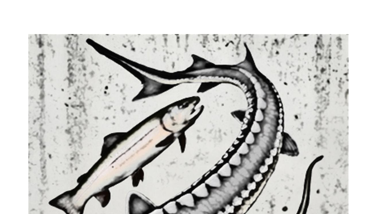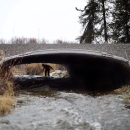This fish passage fish passage
Fish passage is the ability of fish or other aquatic species to move freely throughout their life to find food, reproduce, and complete their natural migration cycles. Millions of barriers to fish passage across the country are fragmenting habitat and leading to species declines. The U.S. Fish and Wildlife Service's National Fish Passage Program is working to reconnect watersheds to benefit both wildlife and people.
Learn more about fish passage document summarizes the state-of-the-science and provides guidelines for implementation of nature-based and technical fish passage solutions. Passage needs for Bull Trout (Salvelinus confluentus), Pacific Lamprey (Entosphenus tridentatus), White Sturgeon (Acipenser transmontanus), and small-bodied (<150 mm) fishes in the Pacific Northwest region of the United States are specifically addressed. These Guidelines include links to useful resources, which should be consulted for more in-depth and detailed information.
To complete their life cycles, most fishes must migrate between habitat types, flow conditions, and thermal regimes, which has become more critical in the face of climate change climate change
Climate change includes both global warming driven by human-induced emissions of greenhouse gases and the resulting large-scale shifts in weather patterns. Though there have been previous periods of climatic change, since the mid-20th century humans have had an unprecedented impact on Earth's climate system and caused change on a global scale.
Learn more about climate change . The longest migrations are typically for anadromous species, such as Pacific Lamprey (Entosphenus tridentatus), that must journey between the ocean and freshwater spawning grounds to complete their life cycles. Additionally, other native aquatic species, such as Western Pearlshell (Margaritifera falcata), Western Ridged (Gonidea angulata) and Floater (Anodonta spp.) mussels, are dependent upon migratory fishes to complete their life cycles by dispersing offspring. On a broader population-level scale, connectivity facilitates the recolonization, range expansion, and migration of native fish species. Preserving and restoring aquatic connectivity will help ensure the long-term viability of fish populations (Olden et al. 2014).
While improving passage at artificial barriers (e.g., dams or weirs) has been a multi-decadal focus for anadromous salmon and steelhead (Oncorhynchus spp.) in the Pacific Northwest, comparatively little attention has been given to passage needs for other culturally and ecologically significant fishes. The goal of this document is to fill that gap, which is timely given the growing interest in Nature-based Solutions and increasing connectivity in freshwater aquatic systems.
Primary objectives of these Guidelines are to:
- raise awareness of the different passage needs for species other than Pacific salmon and steelhead;
- discuss basic passage constraints, such as jump heights, minimum flow depths, and maximum velocities;
- provide general recommendations to improve passage for a variety of fish life histories; and
- provide links








